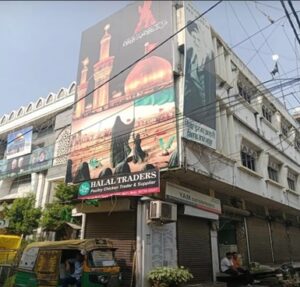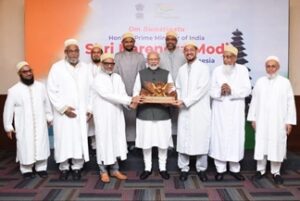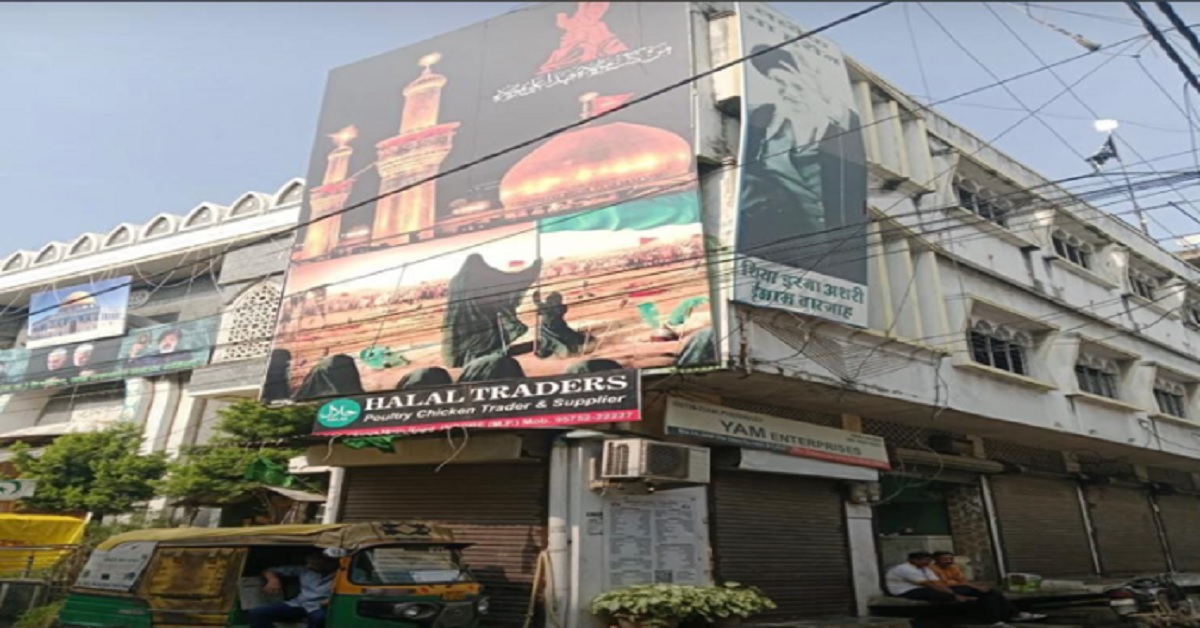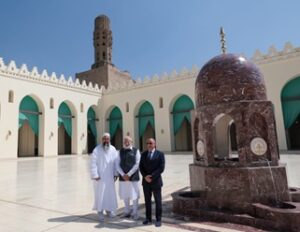On November 3, a controversy erupted in Indore, Madhya Pradesh, after a Muharram poster displayed outside the Shia Imam Bargah in the Kagdipura area was falsely misrepresented online. Right-wing groups quickly seized on the imagery, claiming that the poster, which featured a saffron flag, was promoting the concept of “Ghazwa-e-Hind”—a term linked to extremist narratives of a supposed Islamic conquest of India. These claims, which spread rapidly on social media, falsely portrayed the saffron flag as a symbol of aggression aimed at the Hindu community. This sparked a heated political debate, fuelled by misleading allegations and widespread misinformation, despite the poster’s actual meaning being tied to religious observance and the commemoration of the Battle of Karbala.
Typically, such posters are displayed during Muharram and Arbaeen (in August) and remain up until they fade or are replaced by new ones. The poster in question was part of a longstanding tradition within the Shia Muslim community, serving as a tribute to Imam Hussain’s sacrifice, and was not meant to convey any political or sectarian message.

The situation escalated when BJP Indore Vice-President Aklavya Singh Gour (Convenor of Hindu Rakshak Sangathan), son of MLA Malini Gour, posted on X on November 3, 2024, accusing the Muharram poster of promoting terror and challenging the administration’s peacekeeping efforts. He called for immediate action, urging local authorities to identify and punish those responsible for displaying the poster.
He stated that “This poster depicting the terror of ‘Ghazwa-e-Hind’ put up on a mosque in Kagdipura area of Indore is mocking the administration’s peacekeeping system. The administration is requested to take immediate cognizance and take strictest action against the culprits.”
इंदौर के कागदीपुरा क्षेत्र में एक मस्जिद पर लगाया गया गजवा-ए-हिंद’ के आतंक को दर्शाता यह पोस्टर प्रशासन की शांति व्यवस्था को मुंह चिढ़ा रहा है।
प्रशासन से निवेदन है तत्काल संज्ञान में लेकर दोषियों के विरुद्ध कठोरतम कार्यवाही करें।@DrMohanYadav51 @CMMadhyaPradesh @vdsharmabjp pic.twitter.com/Fy5rgkOwhb— Aklavya Laxman Singh Gaur (@aklavyagaur) November 3, 2024
In his post, he also tagged the Madhya Pradesh Chief Minister Mohan Yadav.
The post quickly gained traction on social media, fuelling a larger debate and drawing attention to the religious symbolism in the poster, which some claimed could potentially inflame communal sentiments. However, this interpretation was contested by many locals, who pointed out that such posters are a common sight during Muharram, a significant religious observance for Shia Muslims, and are not associated with any political or militant agenda. As per Dainik Bhaskar.
Following the same and in an effort to avoid further escalation of tensions, members of the Shia community voluntarily removed the poster, recognising the potential for misunderstanding the context of the poster. This action came in the face of growing social media misinformation and the spreading of divisive narratives, ultimately defusing the situation before it could spiral into broader communal unrest.
Moreover, Additional Commissioner of Police, Indore, Hemant Chauhan stated that “We would like to inform you that after the Shia community meeting at Chatrikura police station, there was a discussion regarding a banner that had been raised concerning a specific issue. Some members of the Shia community also came to meet regarding this matter.” In the video, ACP Chauhan clarified that the poster in question was related to Karbala and was not objectionable in any way, as confirmed by members of the Shia community. ACP Chauhan further stated that, to prevent any misunderstandings, the members of the Shia community themselves voluntarily removed the poster.
Indore, Madhya Pradesh: Hemant Chauhan, ACP, says, “We would like to inform you that after the Shia community meeting at Chatrikura police station, there was a discussion regarding a banner that had been raised concerning a specific issue. Some members of the Shia community also… pic.twitter.com/FdC5jddspl
— IANS (@ians_india) November 4, 2024
BJP MLA Malini Gour’s son, Aklavya Singh Gour, took to his social media handle on X once again, this time claiming that the poster had been removed by the police administration. In his post, he tagged both Madhya Pradesh Chief Minister Mohan Yadav and the Rashtriya Swayamsevak Sangh (RSS), drawing further attention to the issue.
इंदौर के कागदीपुरा क्षेत्र में लगे एक विवादित पोस्टर को संज्ञान में लेते हुए स्थानीय पुलिस प्रशासन ने तुरन्त हटवा दिया, जिसके लिए पुलिस प्रशासन का धन्यवाद एवं आभार।@drmohanyadav51@cmmadhyapradesh#djp_mp@bjp4mp@vdsharmabjp
@rss_org_official pic.twitter.com/y2m7FexKqR— Aklavya Laxman Singh Gaur (@aklavyagaur) November 3, 2024
The poster’s actual meaning and context
The poster in question is a common sight during Muharram, particularly in Shia Muslim areas, and is part of a traditional display honoring the martyrdom of Imam Hussain and his family at the Battle of Karbala. The imagery often includes the presence of Imam Hussain’s sister, Zainab, and his daughter, Sakina, who are depicted witnessing the battlefield after the massacre of their family members. The Arabic inscription on the poster reads, “Man kunto maula fa haza Aliun maula” — a famous phrase meaning, “Whoever I am the leader of, Ali is their leader,” referencing Imam Ali, the first Imam in Shia Islam.
Notably, the saffron flag shown in the poster has been misinterpreted by some as a symbol of Hindu nationalism. However, the saffron flag is a common cultural symbol in many Muslim communities, particularly among Shia Muslims. It is associated with the remembrance of the martyrdom of Imam Hussain, symbolizing sacrifice and the struggle against tyranny. The saffron flag does not carry any sectarian or political message related to the “Ghazwa-e-Hind” or any challenge to Hinduism. It is instead a tribute to the spiritual and historical significance of the event.
BJP’s connection to Shia Muslims
Despite the BJP’s stronghold in Madhya Pradesh, the state government has shown little attention to issues affecting the Shia community, as evidenced by the recent controversy surrounding posters in the city. These posters, which were based on false and misunderstood claims, created tension in the community. Interestingly, many Shia Muslim leaders in India have historically aligned themselves with the BJP, especially during events like Muharram. Prime Minister Narendra Modi has even visited Shia religious sites, such as the Shia Majlis, where he recited Marsiya (elegiac poetry) alongside mourners during Muharram.
Additionally, during his state visit to Egypt in June 2023, Modi visited the historic Al-Hakim Mosque in Cairo, which was restored with the help of India’s Dawoodi Bohra community. The mosque, dating back to 1012, holds cultural and religious significance, particularly for the Bohra community, which traces its roots to the Fatimids. Modi praised the mosque’s intricate restoration, highlighting India’s strong ties with this sect.
On November 15, 2022, during the G20 Summit in Bali, Indonesia, Prime Minister Narendra Modi met with members of the Dawoodi Bohra community.

Image: https://www.thedawoodibohras.com/dawoodi-bohras-welcome-prime-minister-modi-to-indonesia/
It is also an important fact that Pro-BJP Shia leaders are increasingly being rejected by the broader Shia community in India. Their political affiliations are seen as conflicting with the community’s values, leading to a growing disconnect. Many Shias view these leaders as prioritizing political gain over religious unity and community interests.
The political attempt to target the Muslim community with such misguided, manipulated and potentially divisive allegations can be seen as part of a larger strategy to exploit religious divisions for electoral gain. However, it is important for leaders within the community, including pro-BJP Muslim leaders, to understand the dangers of allowing such misinterpretations to spread, as it undermines communal harmony and could eventually backfire, leading to greater polarization.
However, the recent events, including the incident at the Jaipur Shia Imambada, where BJP MLA Balmukund Acharya forcefully entered the premises and misbehaved with Muslim women, serve as a critical lesson for pro-Modi Shia leaders. Despite their support for the BJP, such rising incidents suggest that no one, not even those aligned with the party, may remain immune to its increasingly divisive tactics.
Related:
ISIS Attacks Iran: What Lies Behind the Shia-Sunni Divide
Mumbai’s Shias Stand with Sunni Muslims in Babri Masjid Case: AD

